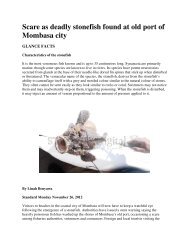Hydrophilous Pollination of a Dioecious Seagrass ...
Hydrophilous Pollination of a Dioecious Seagrass ...
Hydrophilous Pollination of a Dioecious Seagrass ...
You also want an ePaper? Increase the reach of your titles
YUMPU automatically turns print PDFs into web optimized ePapers that Google loves.
<strong>Hydrophilous</strong> <strong>Pollination</strong> <strong>of</strong> a <strong>Dioecious</strong> <strong>Seagrass</strong>, Thalassodendron ciliatum (Cymodoceaceae) in<br />
Kenya<br />
Author(s): Paul Alan Cox<br />
Source: Biotropica, Vol. 23, No. 2 (Jun., 1991), pp. 159-165<br />
Published by: The Association for Tropical Biology and Conservation<br />
Stable URL: http://www.jstor.org/stable/2388301 .<br />
Accessed: 29/12/2010 20:28<br />
Your use <strong>of</strong> the JSTOR archive indicates your acceptance <strong>of</strong> JSTOR's Terms and Conditions <strong>of</strong> Use, available at .<br />
http://www.jstor.org/page/info/about/policies/terms.jsp. JSTOR's Terms and Conditions <strong>of</strong> Use provides, in part, that unless<br />
you have obtained prior permission, you may not download an entire issue <strong>of</strong> a journal or multiple copies <strong>of</strong> articles, and you<br />
may use content in the JSTOR archive only for your personal, non-commercial use.<br />
Please contact the publisher regarding any further use <strong>of</strong> this work. Publisher contact information may be obtained at .<br />
http://www.jstor.org/action/showPublisher?publisherCode=tropbio. .<br />
Each copy <strong>of</strong> any part <strong>of</strong> a JSTOR transmission must contain the same copyright notice that appears on the screen or printed<br />
page <strong>of</strong> such transmission.<br />
JSTOR is a not-for-pr<strong>of</strong>it service that helps scholars, researchers, and students discover, use, and build upon a wide range <strong>of</strong><br />
content in a trusted digital archive. We use information technology and tools to increase productivity and facilitate new forms<br />
<strong>of</strong> scholarship. For more information about JSTOR, please contact support@jstor.org.<br />
http://www.jstor.org<br />
The Association for Tropical Biology and Conservation is collaborating with JSTOR to digitize, preserve and<br />
extend access to Biotropica.
BIOTROPICA 23(2): 159-165 1991<br />
<strong>Hydrophilous</strong> <strong>Pollination</strong> <strong>of</strong> a <strong>Dioecious</strong> <strong>Seagrass</strong>,<br />
Thalassodendron ciliatum (Cymodoceaceae) in Kenya'<br />
Paul Alan Cox<br />
Department <strong>of</strong> Botany and Range Science, Brigham Young University, Provo, Utah 84602 U.S.A.<br />
ABSTRACT<br />
The flowering <strong>of</strong> the dioecious seagrass Thalassodendron ciliatum (Cymodoceaceae) in Kenya is coincident with<br />
extremely low spring tides. Staminate plants release their flowers underwater immediately before the low tide begins<br />
to return. These float to the surface and there they expel the filamentous pollen. The pollen form floating snowflakelike<br />
rafts (search vehicles) that collide on the water surface with the female stigmas. Since pollination occurs on the<br />
water surface, T. ciliatum has a category 2 hydrophilous pollination system, strikingly similar to that <strong>of</strong> Amphibolis.<br />
Seeds <strong>of</strong> the developing fruit germinate precociously and seedling development is viviparous.<br />
UFUPISHO<br />
Mikuku ni niti yenye maua ambayo ina mea kwenye maji madago ya bahori kwenye mwambo wa kenya. Ina zoa<br />
maua katika mwezi wa kuna miti t<strong>of</strong>auti ya kiume na ya kike. Maji ya kifuma, maua ya kiume huwa ya kiogelea<br />
juu juu ya maji ya bahari. Mbelewe (pollen) ya maua ya kiume huwa ikiondoka na kvogelea kwenda kwenye maua<br />
ya kike. Baadaye mimea michanga inaanza kumea kwenye mimea ya kike na baadye huwa ikiachiliwa.<br />
WITHIN THE LAST DECADE, there has been a renewed theoretical predictions; thus a series <strong>of</strong> investigations<br />
interest in abiotic pollination systems, induding hy- on the pollination biology <strong>of</strong> seagrasses has been<br />
drophilous pollination. As defined by Delpino and initiated (Cox 1988, 1990; Cox, Laushman, &<br />
Ascherson (1871), Knuth (1898), Ernst-Schwar- Ruckelshaus 1990; Cox, Elmqvist, & Tomlinson<br />
zenbach (1944), and Cox (1988), hydrophilous 1990; Cox & Knox 1988,- 1989; Cox & Tomlinson<br />
pollination involves water as a vector for the trans- 1988).<br />
portation <strong>of</strong> pollen, or the transportation <strong>of</strong> con- The seagrass genus Thalassodendron den Hartog<br />
veyances (such as the flowers <strong>of</strong> Vallisneria) that (Cymodoceaceae) has two species: T. pachyrhizum,<br />
carry the pollen. For ease <strong>of</strong> discussion, hydrophilous which is confined to limestone reef platforms on the<br />
pollination systems can be divided into three eco- western coast <strong>of</strong> Australia (den Hartog 1970, Kirklogical<br />
dasses: Category 1, in which pollen is trans- man & Cook 1987); and T. ciliatum (Forsk.) den<br />
ported above the water surface; Category 2, in which Hartog, which ranges from East Africa (W. Isaac<br />
pollen is transported on the water surface, and Cat- 1968, F. Isaac 1968) through the Indian Ocean to<br />
egory 3, in which pollen is transported beneath the Indonesia (Brouns 1985), Papua New Guinea<br />
water surface (Ernst-Schwarzenbach 1944, Cox (Johnstone 1984), the Solomon Islands (Johnstone<br />
1988). The use <strong>of</strong> a search theory and dassical 1982), and the northwest coast <strong>of</strong> Australia (Walker<br />
diffusion mechanics has prompted a reexamination and Prince 1987). The taxonomy <strong>of</strong> the genus to<strong>of</strong><br />
hydrophilous pollination systems, since two-di- gether with notes on the structure <strong>of</strong> the floral units<br />
mensional pollination systems with pollen dispersed has been described by den Hartog (1970). The floral<br />
in large aggregations or conveyances have been pre- morphology <strong>of</strong> T. ciliatum has been described by<br />
dicted to be advantageous (Cox 1983). Basic field Isaac (1969) and Kay (1971), pollen development<br />
observations <strong>of</strong> the pollination ecology <strong>of</strong> many hy- by Ducker et al. (1978) and Pettitt (1981), vegdrophilous<br />
plants however are lacking (Cox 1988). etative morphology by Tomlinson (1982), and fo-<br />
Reliable information on the pollination <strong>of</strong> seagrasses liar anatomy by Barnabas (1982). The floral morhas<br />
been particularly needed in order to test these phology <strong>of</strong> T. pachyrhizum has been described in<br />
some detail by Kuo and Kirkman (1987). No pre-<br />
I Received 12 October 1989, revision accepted 23 April vious observations have been reported on the pol-<br />
1990.<br />
lination mechanism <strong>of</strong> either species <strong>of</strong> Thalasso-<br />
159
160 Cox<br />
dendron although Isaac (1969) reported finding an the horizontal shoot becomes erect. The erect portion<br />
anther <strong>of</strong> T. ciliatum in a tide pool with pollen <strong>of</strong> the shoot is distinctly dorsiventral, being elliptical<br />
strings extruded from it.<br />
in cross section, and produces foliage rather than<br />
Thalassodendron ciliatum is called "Mikuku" scale leaves. Older erect shoots may branch, infrein<br />
Swahili and is well known to villagers <strong>of</strong> the quently producing at their base a new horizontal<br />
Watamu area, who readily distinguish it from En- shoot with scale leaves; or, as is more common, they<br />
halus acoroides, which is used as a famine food. produce an erect shoot higher up. If the apex <strong>of</strong> the<br />
original erect shoot is damaged, an axillary bud<br />
beneath the shoot apex may produce a renewal<br />
METHODS<br />
shoot. Erect shoots have a maximum <strong>of</strong> three orders<br />
<strong>of</strong> branching. The erect shoots (Fig. 1A) are disti-<br />
A population <strong>of</strong> Thalassodendron ciliatum was studchous<br />
with alternate leaves, with the flowers <strong>of</strong> pisied<br />
at Watamu Bay on the east coast <strong>of</strong> Kenya<br />
tillate plants being borne on short lateral shoots in<br />
during extremely low spring tides from 20 to 25<br />
the axils <strong>of</strong> leaves near the shoot apices. Thalasso-<br />
October 1988. Several large rhizome systems were<br />
dendron appears to be dioecious, as all <strong>of</strong> the rhizome<br />
unearthed and studied. Twenty male and twenty<br />
systems I unearthed were completely unisexual.<br />
female erect shoots were collected and the number<br />
The flowers are borne on short lateral branches<br />
and distribution <strong>of</strong> flowers on each shoot were reproduced<br />
in the axils <strong>of</strong> foliage leaves near the apex<br />
corded. Male and female floral units in differing<br />
<strong>of</strong> erect shoots. The short lateral shoots bearing the<br />
stages <strong>of</strong> maturity were collected and preserved in<br />
pistillate flowers are two nodes long before pro-<br />
FAA, critical point dried and sputter coated with a<br />
ducing the first <strong>of</strong> four specialized auriculate floral<br />
gold amalgam in preparation for study by scanning<br />
bracts enclosing the axis, with the axis terminating<br />
electron microscopy.<br />
in a floral unit with two carpels. This unit may be<br />
The pollination biology <strong>of</strong> T. ciliatum was studtermed<br />
a "flower," but see Tomlinson (1982) for<br />
ied in the field using snorkel gear. The population<br />
a discussion <strong>of</strong> the comparative morphology <strong>of</strong> such<br />
was observed before, during, and after low spring<br />
structures in the Helobiae. Each carpel (Fig. 1C),<br />
tides for release <strong>of</strong> male floral units. The diameters<br />
which is 2 mm long, contains a single ovule, and<br />
<strong>of</strong> floating pollen search vehicles were measured.<br />
terminates with a style 3-5 mm long, bifurcating<br />
The orientations <strong>of</strong> the stigmas <strong>of</strong> the female plants<br />
into two filiform stigmas, each being approximately<br />
were observed and photographed at low tide.<br />
5.0 cm in length. At maturity, these stigmas pro-<br />
Voucher specimens <strong>of</strong> both male (Cox 1400, 1405)<br />
trude through the bracts and in intertidal plants are<br />
and female (Cox 1401) plants were made and are<br />
exposed to the water surface at extremely low tides<br />
on deposit at the Brigham Young University Her-<br />
(Fig. 1B). The portions <strong>of</strong> stigmas exposed outside<br />
barium (BRY) and the Gray Herbarium (GH) <strong>of</strong><br />
<strong>of</strong> the bracts, however, soon break <strong>of</strong>f subsequent<br />
Harvard University.<br />
to pollination or as the result <strong>of</strong> damage (Fig. 1D).<br />
The stigmatic surface is smooth, with no papillae<br />
or other structures visible (Fig. 2D).<br />
RESULTS<br />
The short shoots bearing the staminate flowers<br />
At Watamu Bay, Kenya, Thalassodendron ciliatum are also borne in the axils <strong>of</strong> foliage leaves, and at<br />
occurs in small depressions in the raised coral plat- the first node produce the first <strong>of</strong> four floral bracts,<br />
form, as large patches in the subtidal, and at the the inner three being distinctly auriculate. The stamouth<br />
<strong>of</strong> Mida Creek, which is a nearby estuary. minate floral unit (hereafter termed "flower") is 1.5<br />
The distichous axes <strong>of</strong> T. ciliatum begin as plagi- cm long, and produces two fused anthers each with<br />
otropic axes, but become orthotropic at the fourth four locules. Inside each locule, the long filamentous<br />
internode, producing the aerial axis. Continuation pollen is tighdy coiled (Fig. 2A). The anthers de<strong>of</strong><br />
the rhizome system is by development <strong>of</strong> a shoot hisce by means <strong>of</strong> longitudinal slits (Fig. 2B), reproduced<br />
from the bud in the axil <strong>of</strong> the scale leaf leasing the filamentous pollen.<br />
at the fourth internode. The architecture <strong>of</strong> the Staminate shoots produce a median <strong>of</strong> eight<br />
rhizome system is therefore sympodial, with the flowers per shoot while pistillate shoots produce a<br />
precision <strong>of</strong> the change <strong>of</strong> the horizontal axis from median <strong>of</strong> two flowers per shoot. These medians<br />
a horizontal to an erect position at the fourth node are significantly different (sign test, P < 0.001).<br />
being most striking. Development <strong>of</strong> the erect shoots During the week <strong>of</strong> 20 October, staminate flowbecomes<br />
more pronounced in order <strong>of</strong> their age. ers were found attached to the staminate plants but<br />
Roots are produced only at the fourth node where they did not abscise in mass until the low spring
;~~~~~~~~~~<br />
<strong>Hydrophilous</strong> <strong>Pollination</strong> 161<br />
FIGURE 1. Thalassodendron ciliatum in Watamu, Kenya. A. Erect shoots with foliage leaves. B. Pistillate plant<br />
at low tide with filiform stigmas protruding from bracts and exposed to water surface. C. Pistillate floral unit with<br />
bracts removed, showing the two carpels each with two filiform stigmas. Grid size = 1 cm. D. Pistillate floral unit,<br />
with the ovary pictured in the front unpollinated, and the other ovule fertilized with the viviparous seedling attached.<br />
Grid size = 1 cm.
162 Cox<br />
@+.~~~~~~~~~~~~ -*d.<br />
4f ~ ~ ~ ~ t~<br />
FIGURE 2. Thalassodendron ciliatum, details <strong>of</strong> staminate floral unit. A. Anther with tip broken <strong>of</strong>f exposing<br />
tightly coiled filamentous pollen. Scale bar = 100 gm. B. Anther dehiscing by longitudinal slit. Scale bar = 1 mm.<br />
C. Filamentous pollen. Scale bar = 100 ,um. D. Thalassodendron ciliatum stigma section. Scale bar = 100 gm.<br />
tides <strong>of</strong> 24 and 25 October which were the lowest reaching the surface, the anthers dehisce and expel<br />
tides in the tidal cyde (Figs. 3, 4A). As the tide the filamentous pollen, and are washed up in mass<br />
returned, the surface <strong>of</strong> the water was filled with on the beach as the tide returns (Fig. 4C). The<br />
the small floating staminate flowers (Fig. 4B). On filamentous pollen grains, when released in this fashion,<br />
float and form snowflake-like search vehides<br />
(Fig. 4D) <strong>of</strong> median diameter 0.95 cm. The ad-<br />
Daily Tidal Fluctuations, Kenya<br />
5<br />
herence <strong>of</strong> the individual pollen "noodles" into search<br />
vehides may be mediated by the coating on the<br />
4<br />
pollen wall formed by the periplasmodial residue<br />
as described by Pettitt (1981). These search vehides<br />
3<br />
are not significantly different in size (Mann-Whitmey<br />
Z = 1.145, P < 0.126) from the search vehides<br />
E<br />
la2<br />
<strong>of</strong> Amphibolis antarctica in the related genus Amphibolis<br />
(Fig. 5) as determined by data previously<br />
gathered by Cox and Knox (1988). As the tide<br />
returned, some <strong>of</strong> the search vehides collided with<br />
0<br />
Thalassodendron<br />
r ase<br />
r<br />
the stigmas exposed at the surface <strong>of</strong> the water (Fig.<br />
1B), thereby effectng pollination. Thalassodendron<br />
5 10 15 20 25 30 5 ciliatum therefore has a type 2 hydrophilous pol-<br />
October November<br />
lination system following the categories proposed<br />
FIGURE 3. Tidal cyde for Watamu, Kenya from 1 by Cox (1988).<br />
Oct. to 5 Nov. 1989. Mass release <strong>of</strong> Thalassodendron After pollination, development <strong>of</strong> the seedling<br />
ciliatum staminate flowers coincided with the lowest spring is viviparous (Fig. 1D) with usually only one <strong>of</strong> the<br />
tides on 25 and 26 Oct.<br />
pair <strong>of</strong> carpels developing into a fruit.
T 8 - I -J<br />
g 'Ut<br />
_<br />
<strong>Hydrophilous</strong> <strong>Pollination</strong> 163<br />
FIGURE 4. Thalassodendron ciliatum A. T. ciliatum population at Watamnu, Kenya exposed by extremely low<br />
spring tide, 26 Oct. 1988. B. Staminate floral unit floating on water surface at low tide prior to dehiscence. C.<br />
Staminate floral unit after dehiscence and pollen release. Grid size = 1 cm. D. Pollen rafts or search vehides <strong>of</strong><br />
Thalassodendron ciliatum pollen floating on water surface at low tide. Grid size = 1 cm.<br />
^~~~~~~~~~~~~~~~~~~~~~~z
164 Cox<br />
Search Vehicle Size Distribution<br />
._C<br />
ThalassodendronW<br />
5 10 15 20 25 30<br />
Diameter (mm)<br />
FIGURE 5. Size distribution <strong>of</strong> pollen rafts or search vehides for two surface-polinated seagrasses, Thalassodendron<br />
ciliatum at Watamu, Kenya and Amphibolis antarctica at Point Lonsdale, Australia.<br />
DISCUSSION<br />
the nearly synchronous underwater abscission <strong>of</strong> staminate<br />
flowers that float to the surface, dehisce, and<br />
In both Kenya and northwestern Australia, Thalasrelease<br />
their pollen forming floating search vehides<br />
sodendron ciliatum has been described as being found<br />
has been previously reported only for Amphibolis<br />
in intertidal pools on "raised reef areas where it is<br />
antarctica in Australia (Cox and Knox 1988, Ducknever<br />
emersed" (W. Isaac 1968, Walker & Prince<br />
er et al. 1978, fig. 15). The similarities in surface<br />
1987). However, F. Isaac in Kenya reported "In<br />
pollination mechanisms between Amphibolis antthe<br />
intertidal area it is never fully exposed although<br />
arctica and Thalassodendron ciliatum are most strikat<br />
low water spring tides the leaves can be seen at<br />
ing, induding viviparous development <strong>of</strong> the seedthe<br />
surface. If the water is very low the flexible<br />
ling, and suggest dose phylogenetic affinities.<br />
stems fall sideways to remain in the water" (F. Isaac<br />
Submarine pollination in either species cannot be<br />
1969, p. 46). It is precisely at these extreme low<br />
exduded on the basis <strong>of</strong> field studies conducted to<br />
tides, when the tops <strong>of</strong> Thalassodendron plants lie<br />
date; information regarding the pollination biology<br />
on the surface <strong>of</strong> the water, that surface pollination<br />
<strong>of</strong> Thalassodendron pachyrhizum, whidc has yet to<br />
occurs. Although when uncovered by the low spring<br />
be found in as shallow water as T. ciliatum (Kirktide,<br />
the leaf tips <strong>of</strong> T. ciliatum show signs <strong>of</strong><br />
man and Cook 1987, Walker and Prince 1987),<br />
desiccation, the plants seemed to exhibit no ill efwould<br />
be most interesting.<br />
fects. It is interesting in this regard that McMillan<br />
(1984) found, in contrast to many other genera <strong>of</strong><br />
seagrasses, that T. ciliatum plants from Kenya were ACKNOWLEDGMENTS<br />
able to withstand high temperature sea water (390C)<br />
I thank Mohammed Alale and James Charo for their<br />
for 36 hours. He found that even though the leaves assistance in data collection and their patience in helping<br />
and apical buds were lost, new leaves were initiated me with Swahili, the Keeper <strong>of</strong> the Herbarium, British<br />
at the bases <strong>of</strong> the stems.<br />
Museum (Natural History) and the Director <strong>of</strong> the Her-<br />
Tidally synchronized rhythms <strong>of</strong> flowering in barium <strong>of</strong> the University <strong>of</strong> Uppsala for access to their<br />
collections, and P. B. Tomlinson for useful discussions.<br />
seagrasses are a common phenomenon (Pettitt 1984),<br />
This study was supported by a National Science Founand<br />
have been studied in Kenya (in Thalassia hem- dation Presidential Young Investigator Award BSRprichii)<br />
in some detail by Pettirt (1980). However, 8452090.<br />
CD
LITERATURE CITED<br />
<strong>Hydrophilous</strong> <strong>Pollination</strong> 165<br />
BARNABAS, ALBAN D. 1982. Fine structure <strong>of</strong> the leaf epidermis <strong>of</strong> Thalassodendron ciliatum (Forsk.) Den Hartog.<br />
Aquat. Bot. 12: 41-55.<br />
BROUNS, J. J. W. M. 1985. A preliminary study <strong>of</strong> the seagrass Thalassodendron ciliatum (Forsk.) Den Hartog<br />
from Eastern Indonesia. Biological results <strong>of</strong> the Snellius II Expedition. Aquat. Bot. 23: 249-260.<br />
Cox, P. A. 1983. Search theory, random motion, and the convergent evolution <strong>of</strong> pollen and spore morphologies<br />
in aquatic plants. Am. Nat. 121: 9-3 1.<br />
1988. <strong>Hydrophilous</strong> pollination. Annu. Rev. Ecol. Syst. 19: 261-280.<br />
In Press. Water-pollinated plants. Sci. Am.<br />
T. ELMQVIST, AND P. B. TOMUNSON. 1990. Reproductive morphology and submarine pollination in<br />
Syringodium filiforme (Cymodoceaceae). Biotropica 22: 259-265.<br />
, AND R. B. KNox. 1988. <strong>Pollination</strong> postulates and two-dimensional pollination in hydrophilous monocotyledons.<br />
Ann. Mo. Bot. Gard. 75: 811-818.<br />
, AND . 1989. Two-dimensional pollination in hydrophilous plants: convergent evolution in the<br />
genera Halodule (Cymodoceaceae), Halophila (Hydrocharitaceae), Ruppia (Ruppiaceae), and Lepilaena (Zannichelliaceae).<br />
Am. J. Bot. 76: 164-175.<br />
, R. H. LAUSHMAN, AND M. H. RUCKELSHAUS. In Press. Surface and submarine pollination in Zostera marina<br />
L. Bot. J. Linn. Soc.<br />
, AND P. B. TOMLINSON. 1988. The pollination ecology <strong>of</strong> a Caribbean seagrass, Thalassia testudinum<br />
(Hydrocharitaceae). Am. J. Bot. 75: 958-965.<br />
DELPINO, F., AND P. ASCHERSON. 1871. Federico Delpino's Eintheilung der Pflanzen nach dem Mechanismus der<br />
dichogamischen Befruchtung und Bemerkungen iuber die Befruchtungsvorgainge bei Wasserpflanzen. Mitgetheilt<br />
und mit einigen Zusitzen versehen von P. Ascherson. Bot. Zeitung (Berlin) 29: 443-445, 447-<br />
459, 463-467.<br />
DEN HARTOG, C. 1970. The sea-grasses <strong>of</strong> the world. Verhandl. Kon. Ned. Akad. Wet. Nat. 59 (1). North<br />
Holland, Amsterdam.<br />
DucKER, S. C., J. M. PmrITr, AND R. B. KNox. 1978. Pollen development and submarine pollination in Amphibolis<br />
antarctica and Thalassodendron ciliatum (Cymodoceaceae). Aust. J. Bot. 26: 265-285.<br />
ERNST-ScHWARZENBACH, M. 1944. Zur Bliitenbiologie einiger Hydrocharitaceen. Ber. Schweiz. Bot. Ges. 54: 33-69.<br />
IsAAc, F. M. 1968. Marine botany <strong>of</strong> the Kenya Coast. 4. Angiosperms. J. East Afr. Nat. Hist. Soc. 27: 29-47.<br />
1969. Floral structure and germination in Cymodocea ciliata. Phytomorphology 19: 44-51.<br />
IsAAc, W. E. 1968. Marine botany <strong>of</strong> the Kenya Coast. 2. A second list <strong>of</strong> Kenya marine algae. J. East Afr. Nat.<br />
Hist. Soc. 27: 1-28.<br />
JOHNSTONE, I. M. 1982. Ecology and distribution <strong>of</strong> the seagrasses. Monogr. Biol. 42: 497-512.<br />
1984. The ecology and leaf dynamics <strong>of</strong> the seagrass Thalassodendron ciliatum (Forsk.) den Hartog. Aust.<br />
J. Bot. 32: 233-238.<br />
KAY, Q. 0. N. 1971. Floral structure in the marine angiosperms Cymodocea serrulata and Thalassodendron ciliatum<br />
(Cymodocea ciliata). Bot. J. Linn. Soc. 64: 423-429.<br />
KIRKMAN, H., AND I. H. COOK. 1987. Distribution and leaf growth <strong>of</strong> Thalassodendron pacbyrhizum Den Hartog<br />
in Southern Western Australia. Aquat. Bot. 27: 257-266.<br />
KNUTH, P. 1898. Handbuch der Bliitenbiologie. Band I, II. Leipzig: Verlag von Wilhelm Engelmann.<br />
Kuo, J., AND H. KIRKMAN. 1987. Floral and seedling morphology and anatomy <strong>of</strong> Thalassodendron pacbyrhizxum<br />
den Hartog (Cymodoceaceae). Aquat. Bot. 29: 1-17.<br />
McMiiLAN, C. 1984. The distribution <strong>of</strong> tropical seagrasses with relation to their tolerance <strong>of</strong> high temperatures.<br />
Aquat. Bot. 19: 369-379.<br />
PETrIrr, J. M. 1980. Reproduction in seagrasses: nature <strong>of</strong> the pollen and receptive surface <strong>of</strong> the stigma in the<br />
Hydrocharitaceae. Ann. Bot. 45: 257-271.<br />
1981. Reproduction in seagrasses: pollen development in Thalassia hemprichii, Halophila stipulacea and<br />
Thalassodendron ciliatum. Ann. Bot. 48: 609-622.<br />
1984. Aspects <strong>of</strong> flowering and pollination in marine angiosperms. Oceanogr. Mar. Biol. Annu. Rev. 22:<br />
315-342.<br />
TOMLINSON, P. B. 1982. Helobiae (Alismatidae). In C. R. Metcalfe (Ed.). Vol. VII, Anatomy <strong>of</strong> the monocotyledons.<br />
Clarendon Press, Oxford, England.<br />
WALKER, D. I., AND R. I. T. PRINCE. 1987. Distribution and biogeography <strong>of</strong> seagrass species on the northwest<br />
coast <strong>of</strong> Australia. Aquat. Bot. 29: 19-32.



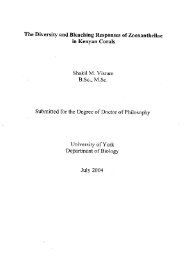
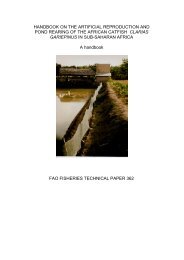

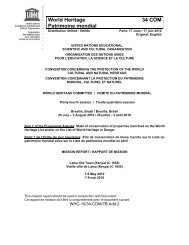
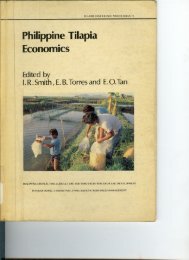
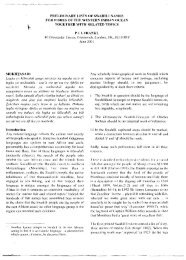

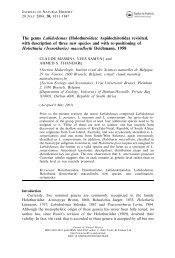
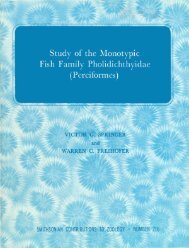

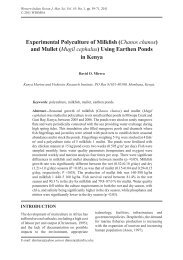
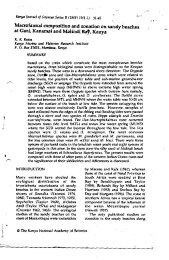
![MSc. Thesis - Lang'at[1].pdf](https://img.yumpu.com/10016993/1/184x260/msc-thesis-langat1pdf.jpg?quality=85)
